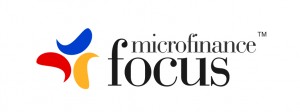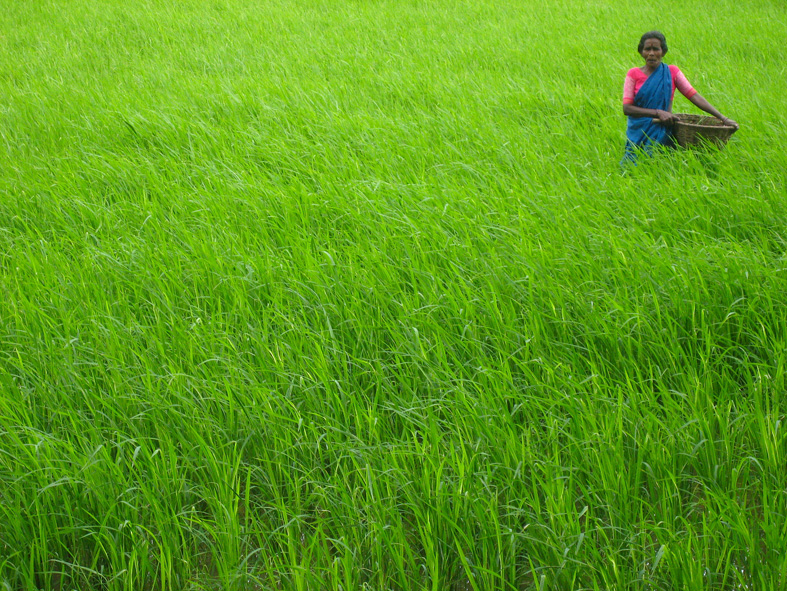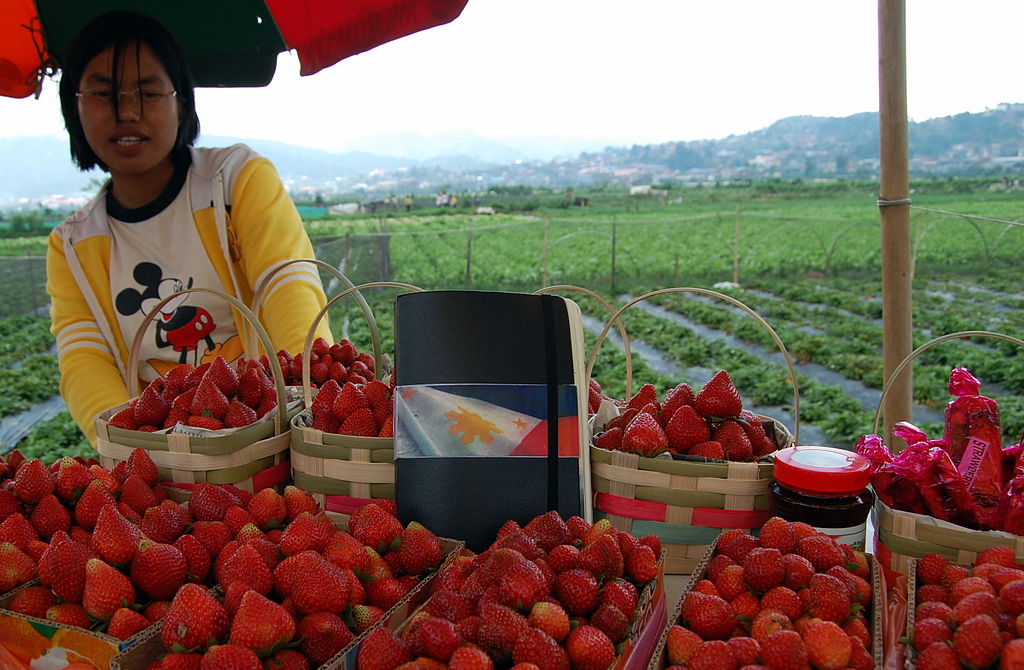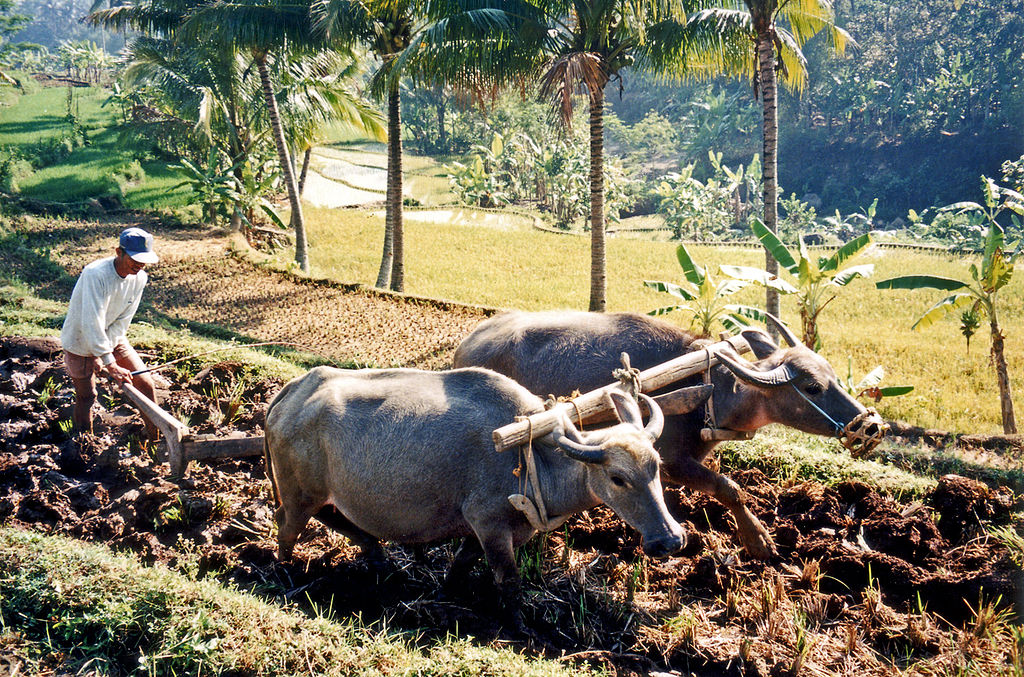The Design and Delivery of Effective Agri-Microfinance
13:30 to 15:00 CST: Much of the world population must subsist on only $2 a day, and many among them are smallholder farming families. Although these small farmers would benefit from microfinance assistance, they have unique needs that are subject to factors such as fluctuating food prices and the agricultural cycle, with these geographical influences varying from one area to another. This can make the successful design and delivery of agri-microfinance more challenging.
This panel session, moderated by Mr. Graham MacMillan, Senior Program Officer of Financial Inclusion at the Citi Foundation, looked at the delivery channels, products, and/or business models that need to be developed to address the risks and cash flows of agriculture – and addressed what’s working and what is not in the realm of agricultural finance. The panel also addressed how best client needs can be translated into feasible products, as well as the design of appropriate client assessment techniques.
Mr. Graham MacMillan, Senior Program Officer of Financial Inclusion at the Citi Foundation, introduced the panelists, praising their expertise and the wide geographic reach of their work.
The purposes of today’s session will focus largely on small land-holding farmers who grow crops as an element of their revenue or for subsistence, said Mr MacMillan, most of whom are unorganized. The session will also take a close look at these farmers household finance needs, and the specific inputs that they require – including seasonality, engagement through delivery systems, and other needs.
First to speak was Ms. Laura Goldman, Project Manager at Dalberg Global Development Advisors, who spoke about reaching smallholders by means of direct-to-farmer finance. The Initiative for Smallholder Finance commissioned the research that Ms. Goldman cited.
In 2012, Dalberg, with support from the Citi Foundation and Skoll Foundation, released the report “Catalyzing Smallholder Agricultural Finance, which described five pathways for closing the gap between the supply of and demand for smallholder finance. The Initiative for Smallholder Finance – a multi-donor effort focused on research, facilitation and brokering – now works towards closing the gap in a time-bound three-year effort. Dalberg led research with the initiative into the realm of Direct to Farmer finance, which involved work with experts and other institutions that specialize in the area.
What were the key learnings from this landscape work? Ms. Goldman described three key challenges: meeting smallholders unique and often highly seasonal cash flows, managing risks that are associated with lending to smallholder farms (such as a lack of knowledge of agricultural best practices and price risks) and problems associated with delivering financial products and services to smallholder farmers, such as high cost and infrastructure challenges. In addition, finance providers operating in this sector often find it hard to locate staffers who have both financial and agriculture expertise.
The research highlighted several common practices taken by providers to address these challenges. One common practice is offering agriculture-specific products, often in the form of a seasonal loan. Some less common approaches include asset-based financing, and some commitment savings products designed for agriculture. myAgro in Mali is an example of a provider offering such a commitment savings product, allowing villagers to buy scratch-off cards with credit that is applied towards a future delivery of high-quality inputs. Another common practice is bundling credit with insurance – including emerging examples of providers bundling agricultural insurance with their credit products.
Outside of insurance, some providers require mandatory savings accounts as a form of collateral from farmers. Access to agronomic support services is also of great import, with some providers offering them in house, while others work with partners. Groups remain more common that individual lending, said Ms. Goldman.
Through its research, Dalberg identified four business model archetypes, said Ms. Goldman. The first is “Build and Integrate,” developed to serve smallholders, often those in the non-commercial segment, in a very integrated, hands-on and field-based way. “This translates into a deep understanding of smallholder needs,” she said. However it also typically results in a relatively low client to field officer ratio, creating recruiting and training challenges for some providers. These providers also often require some philanthropic support to cover costs. She cited One Acre Fund in East Africa as an example.
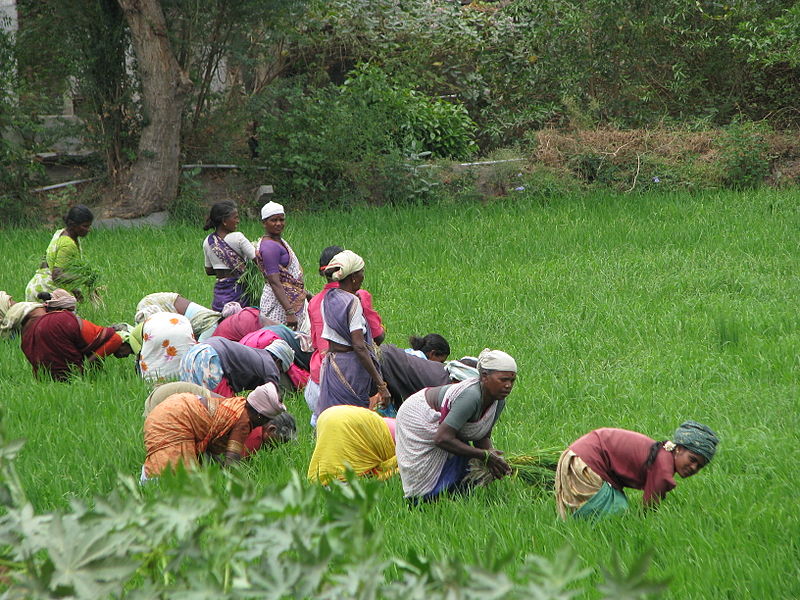
Women harvesting rice paddy in Tamil Nadu, India. Uploaded by Fowler&fowler. From Wikimedia Commons.
The Build and Partner model takes a field-based approach to financial services, but unlike the first, partners with outside organizations to deliver agronomic training. This results in higher client to officer ratios, and also typically makes it more financially sustainable. Juhudi Kilimo in Kenya is an example of this model, said Ms. Goldman.
The third is Leverage and Network, in which providers serving other segments move towards working with a smallholder client base. They use existing resources and put them towards smallholder lending, often with a branch-based approach. They are more commercially oriented and again rely on partners to deliver agronomic services. For some providers, commercial pressures present a particular challenge to scale. Opportunity International represents this model, using an innovative approach to client assessment and low-cost delivery channels to serve smallholders.
The last is Extend and Mobilize, in which community lenders extend their existing product and services lines to meet members’ agricultural needs. Member savings are deployed for credit products, and the approach to agricultural support is often delivered by individual community members. Constraints on scaling are often internal, including a reliance on a member savings pool and institutional capacity.
How to close the gap? Ms. Goldman called for a deeper understanding of each business model, allowing them to be better linked to the most appropriate client base. She also called for more knowledge sharing, as well as additional innovation in the space that could help overcome these scaling challenges.
Next to speak was Mr. Conor Smith, Manager at Proximity Designs in Myanmar, who described the market there as “very, very new – only a few years old.”
“In the past three to five years, there have been significant reforms in Myanmar – socially, economically, and now financially,” said Mr. Smith. The Asian nation is Southeat Asia’s poorest and 62 percent earn less than $5 a day, he said, and financial needs become even more dire in the rural population, who comprise over half the population. The nation has a high demand for microfinance but suffers from an extremely low supply, with 62 percent of the population with no access whatsoever. Myanmar’s government bank is large but moves very slowly, forcing people in the direction of informal money-lenders.
Proximity Designs was founded in 2004. “It’s really focused on human centered products, designing what they need,” said Mr. Smith, including solar energy and irrigation products. It has developed a distribution network that can reach 80 percent of Myanmar’s population and has grown quickly, serving approximately 200,000 unique customers to date. “It’s an unparalleled distribution network that we currently have,” he said.
The company got into microfinance after Cyclone Nargis devastated Myanmar’s agriculture in 2010, with cash liquidity services operating as one aspect of relief efforts. Their first product was specific to the rice market and operated on their cycles at about $150 per loan, with high payment rates.
In 2012, microfinance became a regulated industry in Myanmar, and the company was awarded a license to start its own business unit, Proximity Finance. It has expanded from 10,000 in 2012 to 21,000 customers in 2013, with 37,000 planned for 2014. “In doing so we’re really focusing on diversification of our portfolio,” said Mr. Smith, moving from the Delta region to the north of the nation. The portfolio is sustainable and growing.
Diversification is three fold for Proximity Designs, said Mr. Smith, incorporating geographic diversification, diversification of loan products, and additional financial services – moving into offering not just credit, but also savings, insurance, and even payments. This will require a regulatory framework that is both practical and sustainable. New products include an “On the Move” loan for people who wish to relocate.
The second focus for Proximity Designs is institution building, which will include building several branch offices and hiring staff, or moving it from Proximity Designs to Proximity Finance. Capacity building will then become very important, as the Myanmar microfinance sector begins to grow.
“Ultimately, we think we’re in a unique position in a unique market,” said Mr. Smith, citing Proximity Designs decade of experience, the newness and size of the market, and other factors. The company aspires to be Myanmar’s leading provider of rural financial services, with comprehensive financial solutions.
Next to speak was Mr. Yi Jiang, Environmental Economist at the East Asia Department of the Asian Development Bank (ADB), who discussed the bank’s ongoing experience in financing the Chinese Agricultural sector. ADB works across numerous sectors in China, with agricultural sector priorities including rural land and environmental protection, rural renewable energy development, rural social and microfinance services, and SME finance which will help people enhance their rural livelihood opportunities.
Mr. Jiang described ADB’s financial intermediation loans, abbreviated to FIL. ADB lends to the government, the government then lends loan proceeds to financial intermediaries (FIs), and finally, the FIs lend to the sub-borrowers – usually from the private sector. “Compared to many other ADB projects, the sub-borrowers in this case are smaller and need financing for shorter term – such as 1 to 5 years,” he said.
ADB offers sovereign terms while lending to the government, usually 25 years with a 5 year grace period, while the interest rate is set based on LIBOR which is currently around one percent. The government lends to FIs at the same cost as that of raising funds locally, while FI lends to sub-borrowers at market-based terms, taking on their credit risk.
What are ADB’s eligibility criteria for FIs? They must be solid, have good governance, good corporate strategy, economy in decisions, and importantly, a commitment to ADB’s safeguard requirements. The bank sets up environmental and social management system with these FIs, says Mr. Jiang, helping ensure sub-projects financed by these loans meet ADB’s social and environmental requirements.
Mr. Jiang is currently working on processing the Gansu Featured Agricultural and Financial Services System Development Project, addressing this particularly poor region of China, with 88 percent living in rural areas. The average farmers net income is only about $500, 42 percent of the national average, with land holdings that average less 3
Traditionally the crop is mainly grain, but farmers are now moving towards economic crops such as vegetables and medicinal plants,” he said, a shift that was happening slowly, while livestock husbandry has high potential in the project area. Players include rural credit unions, the Agricultural Bank of China, and local commercial banks such as the Bank of Lanzhou, and the Bank of Gansu, as well as emerging microfinance institutions.
What are the challenges in the Gansu project area? Small farmers need external assistance to grow their crops, and they have low skills and low capacity to get their crops to market – requiring more help from agricultural enterprises and cooperative markets. They must deal with agricultural risk, and they also lack financial resources and access to credit, said Mr. Jiang.
The ADB will lend $100 million through the project, with counterpart funds from the government, FIs and beneficiaries. Sixty-two percent of the loan wll be onlent to sub-borrowers which are farmers, cooperatives and agro-enterprises, 27 percent are relent to RSFPs (rural financial service providers), both through FIs, while 15 percent are devoted to capacity building for the beneficiaries. The fund flow thus moves from ADB, to the government, to FI’s, and from there to sub-borrowers directly and RSFPs. Funds will also flow from RSFP’s to sub-borrowers, said Mr. Jiang.
Finally, the government plans to create a fund with the interest revenues it receives, which it will use to strengthen capacity and increase the creditworthiness of its targeted sub-borrowers, said Mr. Jiang.
Last to speak was Mr. Mitch (Tomas) Gomez, Governing Board Member at the Agricultural Guarantee Fund Pool (AGFP), Philippines. He began by discussing how bank lending to small farmers in the Philippines was historically limited to those who held title to their lands, and used as collateral for loans. This scheme excluded farmers who did not own land or farmers who benefited from a land reform program but had yet to get title to their farms.
Eight years ago, rural banks developed collateral-free agri-microfinance products for farmers, where 60 percent of the loan is amortized weekly, and 40 percent in the form of bullet payment at harvest. This product, however, still excluded small tenant farmers without a weekly cash flow. Farmers with very limited weekly cash flow are the majority of tenant farmers.
In 2008, the Agricultural Guarantee Fund Pool (AGFP) was created. AGFP is a state credit guarantee program designed to encourage private lending directly to small farmers. AGFP provides an all-risk guarantee (except lender fraud). The maximum loan is capped at $20,000, while the average loan guaranteed under the program is $800. The guarantee covers 85 percent of the loan principal with the lender taking risk for the rest. The lender pays a 2 percent guarantee fee.
The program has an initial funding of $100 million and can guarantee up to $300 million in loans to farmers. Eligible guarantee partners are Banks, MFIs, NBFCs, Coops and so forth, with a 20 percent risk weight on assets (for banks). The AGFP is separate from and complementary to crop insurance, said Mr. Gomez.
Target end-borrowers of the fund are tenant farmers who don’t own or hold title to their land, and possess less than 7 hectares, said Mr. Gomez. The eligible crops are rice, corn, vegetables, fruit, and other cash crops; while poultry, swine, goats, and cattle are also included, as well as coastal fishermen and fishpond operators.
“Traditionally tenant farmers in the Philippines get their credit from informal sources – and they definitely charge much more,” said Mr. Gomez of the program benefits. Under this credit guarantee program, farmers enjoy repayment cycle matching their cash flow, lower interest rates, and flexibility to choose their own seeds, fertilizers, and other farm inputs. They also benefit from the ability to sell their harvest to anyone, to sell at any price, and to access others services provided by Banks or MFIs.
“The fund has facilitated growth in private lending to the target farmers,” said Mr. Gomez, from $ 6.6 million in loans guaranteed in 2008 up to $122.8 million at the end of 2013. The number of farmers benefited rose from less than 4,000 in 2008 to 108,000 in 2013. Claims paid to guarantee farmers also increased from $ 550,000 thousand in 2009 to $ 5.2 million in 2013. While claims are increasing, there are recoveries from these claim payments. The guarantee payment, however, said Mr. Gomez, does not eliminate the loan liability of the farmer.
To be sustainable, i.e. if guarantee fees are to equal claims, the fees must be 3x more. Banks and MFIs are the most active guarantee partners of the program accounting for 55% and 21%, respectively, of all loans guaranteed. Before the AGFP, bank lending to these farmers was close to zero. The fund is also underutilized, operating at only 47 percent of its guarantee capacity – highlighting a need for more partners, whose numbers have diminished over time. “This tells us even rural banks that want to help small farmers don’t have the skills or competencies to lend to this sector,” said Mr. Gomez.
Finally, Mr. Gomez stressed that while the credit guarantee program works, the guarantee itself is not enough. As a bank president, Mr. Gomez found that after his bank rushed out a loan product without doing proper research, with lax product design, and without benefit of a pilot, the roll-out went poorly. Without a deliberate product design approach, it led to initial disappointment. Similar experiences happened with other program participants resulting in a drop in guarantee partners for AGFP.
“Fortunately, about three or four years ago at GM Bank, we were the beneficiary of an EU technical assistance program on developing loan products for small farmers” said Mr. Gomez. Working with ACCESS Advisory, Inc., this allowed them to improve their offerings with proper market research, product design, pilot program, and better distribution, loan, and monitoring parameters.
Mr. MacMillan than addressed questions to the panelists, asking Ms. Goldman how many of these smallholders actually would like to expand. “In certain cases, credit isn’t going to be the answer, at least initially,” said Ms. Goldman, describing commitment savings plans as an example of an interesting solution – allowing clients to accumulate savings and, as they increase their production and income, potentially become eligible for additional financial products.
What is the cost of all of these schemes, and what is the cost of serving these clients – and is it commercially viable?
“Yes, we do believe it is commercially viable – that’s the short answer,” said Mr. Smith, referring to Proximity Designs considerable experience and its usage of 5 to 10 leveraged community members in its processes, using them to determine if community members are credit-worthy individuals.
“Putting forward a lot of money into research and development makes it harder for us to keep our costs down,” said Mr. Smith, noting that they are not actually taking that cost on themselves, but are supported by philanthropic investments.
“Providing financial support to small landholders is a very challenging thing,” said Mr. Jiang, referring to the traditional system of direct, subsidized loans. He cited the FIL model, the beauty of which is its ability to remove subsidy from the government and request the FIs to take the full risk of the sub-borrowers, introducing a market-based approach.
We also encourage them to lend at the market rate, and government has to accept this arrangement if they want to go that way,” said Mr.Jiang. Intermediaries make the final decisions, while ADB sets a certain scope of sub-borrowers so that they may serve an area or group with particular development impacts.
“We expect the loan proceeds of this project to be lent to sub-borrowers at similar rates as the market rates,” said Mr. Jiang, who said the project is still being developed, but “I feel increasingly confident we can work it out.”
“In the Philippines, there’s very little state lending directly to farmers. That’s been gone for 20 years,” said Mr. Gomez, which prompted the creation of the guarantee fund. The fund has helped accelerate his bank’s ability to identify clients, the guarantee allowing them to enter the market more swiftly and with more confidence.
“All state guarantee programs have to end anyway, when the money runs dry,” said Mr. Gomez. “We are increasingly confident that once the credit guarantees are taken out, we can still look for more clients but with a different approach – but certainly the clients we already have now, we will continue to serve them.”
“It is commercially viable for us because it has to be,” said Mr. Gomez. “Otherwise, we kill the product.”
Mr MacMillan was joined by speakers Mr. Conor Smith, Manager at Proximity Designs, Ms. Laura Goldman, Project Manager at Dalberg Global Development Advisors, Mr. Tomas Gomez IV, Governing Board Member at the Agricultural Guarantee Fund Pool (AGFP), and President of GM Bank of Luzon, Philippines, and Mr Yi Jiang, Environmental Economist at the East Asia Department of the Asian Development Bank (ADB).
The panel was facilitated by the Citi Foundation.
